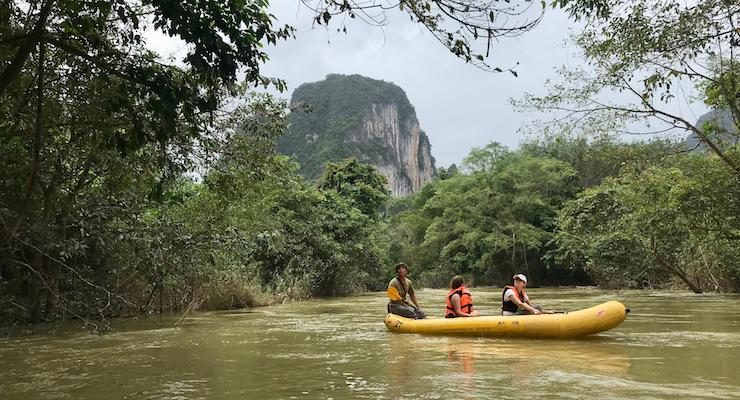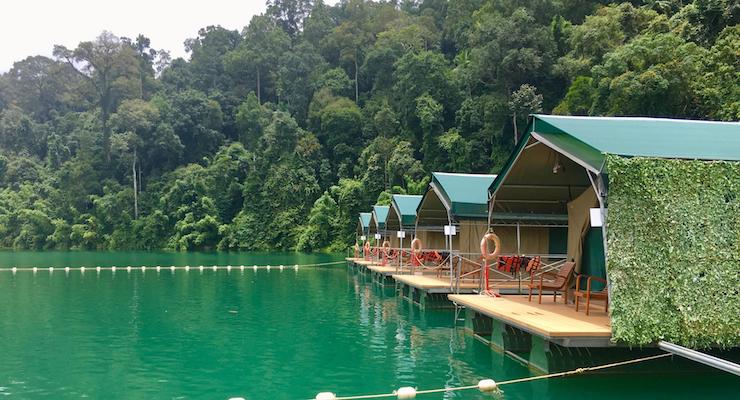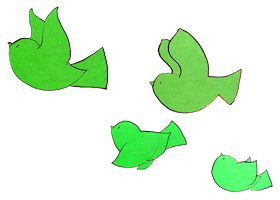When you stay at Elephant Hills tented jungle camp in Thailand, all of the scheduled adventure activities are included, as well as your accommodation, meals and transfers. When you book, you need to think about which activities you’d like to do, so that you choose the package which is right for you. Elephant Hills is in the ancient rainforest of Khao Sok National Park, in the south of the country. When I was there on a family trip in August, we booked a four-day Rainforest Nature Safari, which meant that we experienced all of the activities on offer at Elephant Hills. (The only thing that we didn’t do was to stay overnight at the floating lake camp, but we did spend a day there).
I’ve already written about what it’s like to stay at Elephant Hills. This post is about the activities which you can experience there. I was travelling with my husband and our two kids (15 and 20).

Elephant feeding time, Elephant Hills, Thailand. Copyright Gretta Schifano
Elephant experience
Elephant Hills cares for 12 rescued female elephants at a sanctuary a short distance from the jungle camp. Each elephant has a mahout to care for them. We spent time observing the elephants, then we watched them swimming in their water hole and we helped to wash them afterwards. The elephant who our family washed was called Tim, and our guide, Tor, told us that Tim is the ‘naughtiest’ elephant there. After washing the elephants we helped to prepare their food. The food was laid out on a long table with chopping boards and knives, ready for us to prepare and to put into buckets. We had to separate the bananas, chop whole pineapples into four pieces, chop thick bamboo into sections and roll balls of tamarind in rock salt. I fed a blind elephant, and Tor showed me how to put one hand on her trunk to let her know when I was offering her food with the other hand. After feeding time we went into the wooden Elephant Cafe and watched a film about elephants and conservation. The film explained how in the past elephants were made to work in the logging industry in Thailand, and how the mahouts couldn’t afford to feed the animals when this practice became illegal. Many of these elephants now work in tourism, and some are treated badly, I’m sad to say. Elephant Hills have won many animal welfare awards for their ethical elephant experience.

Canoeing, Sok River
The Sok River runs right next to the jungle camp, and sometimes this excursion starts from there. When we visited, the water level was very high, so we were driven in an open-sided bus to a place along the river where it was safe to set off from. We were in a group of 10 guests, led by one of the friendly local guides, Tor.
We were each given a life jacket, and then travelled along the river in inflatable kayaks, marvelling at the spectacular landscape. Steep limestone karsts soar towards the clouds from the ancient rainforest through which the river winds. We travelled two passengers to a boat, with a local boatman paddling, and it was a peaceful, relaxing experience moving gently along the river. The boatmen were looking out for wildlife as we went along, and we saw a bright green snake curled up asleep in the branches of a tree above us, and a large, motionless monitor lizard on the river bank.

Canoeing with Elephant Hills, Sok River, Thailand. Copyright Sal Schifano
Cheow Larn Lake floating camp
Cheow Larn Lake is in the middle of Khao Sok National Park, and is about an hour’s drive from the Elephant Hills jungle camp. The lake covers around 63 square miles, and was created by the enormous Ratchapratha dam project in 1982. The lake contains more than 100 jungle-clad limestone islands, and the area is a haven for wildlife. Elephant Hills have a floating tented camp on the lake, where guests can spend the day (as we did) or stay overnight.
After breakfast we set off from our jungle camp in an open sided bus. We were in a group of 12, with our local guide Good. We drove to the lake through the jungle and the mountains and on the way we stopped at a local market and then at a viewpoint to see the dam which created the lake. We drove on a further five minutes to a harbour on the lake, where we boarded a traditional wooden long tail boat, and put on our life jackets. The scenery as we travelled across the lake was spectacular. The journey took an hour or so until we reached the floating lake camp. It’s a really peaceful, unspoilt place, only accessible by boat. I had a look inside one of the tented cabins for overnight guests at the lake – inside it was the same as the one we were staying in at the main camp – you can watch a short video of what our tent was like, with a brief shot of the floating camp, here:
Outside, each cabin has a deck with a ladder leading down into the lake. Everyone at the lake camp has to wear a life jacket in the water, even for swimming.
We had a delicious Thai lunch at the lake camp, including vegan dishes for my daughter and me. After lunch my husband and I went kayaking for a while, in a double kayak. I’d been kayaking a couple of times before, but it was my husband’s first time. I was in front and I found it quite hard to paddle because (according to our daughter, who was watching) my husband ‘wasn’t doing it properly’! So our kayaking expedition didn’t last for long.
Back at the lake camp, we went swimming in the lake and sunbathed on the camp’s wooden deck before taking the long tail boat back across lake, and then the bus back to camp.

Elephant Hills floating camp, Cheow Larn Lake, Thailand. Copyright Gretta Schifano
Mangrove Exploration
Our guide for the Mangrove Exploration day was Bua, and we were in a group of 14. We drove west towards the Andaman coast from Khao Sok in an open-sided bus. On the way we stopped at a local market in Takuapa, near to Kao Lau, and then we drove to a quiet place by a river where we were given life jackets before boarding a couple of speed boats for our trip through the mangroves.
There were two local boatmen on our boat: one was the skipper and the other acted as chief wildlife spotter. We went along a wide river and then turned off into a narrow channel through the mangroves to look for wildlife. We saw a few snakes (mangrove snakes and red tailed razers), two large monitor lizards and, thrillingly, a pair of pale brown long-tailed macaques. They were following along in the branches right above the boat, quietly watching us.
Back on the main river, we sped along towards the traditional junk boat where we were having lunch. We spent a few hours on what was actually two junks tied together. There was plenty of room to relax on board. One boat had a kitchen, dining area and upstairs sun deck. The other had benches, a loo, a central shaded area with tea and coffee supplies and an open deck at the back. When we arrived we were offered tea, coffee and bananas, and then Bua said that we could go kayaking. I’d been feeling lightheaded that morning, so I decided not to go. The kids didn’t fancy it either, so the three of us stayed on the junk while the rest of the group went kayaking – my husband shared a boat with Bua. While they were out on the water, my daughter and I sunbathed on the top deck of the boat, while my son relaxed in the shade. The two boatmen started preparing lunch in the kitchen, and it was all very peaceful and relaxing – until the kayakers came back and told us of their adventure. They’d gone to explore a narrow channel in the mangroves and had passed close to a deadly snake which was on a low branch. Bua had spotted it, identified it as a mangrove pit viper and warned everyone to steer clear of it. As some of the group hadn’t kayaked before, I think they were a bit panicky – but everyone managed to avoid the snake. I was quite glad not to have gone kayaking!
The next activity was river swimming from the junk, wearing life jackets. I went in the water to cool off, and it was very refreshing. Some of others in the group jumped into the river from the top deck of the boat.
Then we enjoyed a delicious Thai lunch, prepared on board. After lunch we had time for more sunbathing and swimming, before piling on to a speedboat for the journey back to the bus.

Long-tailed macaque in the mangroves, Thailand. Copyright Gretta Schifano
Jungle trek
On our last morning at Elephant Hills we went on a jungle trek. Good was our guide, and there were 10 of us in our group. Before we set off, Good gave each of us a sturdy stick to use to help us to balance on the trek. We walked down to the river next to the camp, and crossed over it in inflatable canoes, paddled by local boatmen. There were three passengers in each boat, and all of us passengers wore life jackets. We walked through the rainforest for about an hour and a half, stopping along the way so that Good could tell us about the plants and wildlife. He showed us rubber plants, giant bamboo, 350 year-old trees with huge roots, and many other things, as we walked through water and mud, and over rocks, scrambling as we went. It was slippery in places and the sticks were a help.
We eventually arrived at a clearing with a cooking shelter and a high table made of branches. A man was there cooking our lunch over an open fire. He helped us to wash our hands by pouring water for us from a hollow branch. He then showed us how to prepare the food that he was making. First he chopped a coconut in two with a big knife, then he grated the coconut flesh using a wooden device (called a ‘rabbit’ in Thai). Next he squeezed out the juice from the grated coconut with his hands, and cooked it with rice. He made pork and chicken dishes, rice and vegetable soup. For dessert he chopped up pineapple for us. The vegetable soup and rice were very tasty, and the meat-eaters all said that they enjoyed the pork and chicken. While we were eating, our cook placed some smouldering coconut shells under the table as an insect repellent. After lunch we walked back to camp, crossing the river in canoes as before.

Lunch cooked in the jungle, Elephant Hills, Thailand. Copyright Gretta Schifano
Cost
You can book direct with Elephant Hills (in which case each adult in your party will be given a free ranger safari shirt) or you can book as part of an organised trip with a tour operator such as Kuoni. Accommodation, meals, activities and transfers are included, the only extra costs are your drinks and tips to the staff. The four-day Rainforest Nature Safari which we did costs from around £550 per adult, £275 per child (4-15), depending on the season.
Verdict
I enjoyed all of the activities at Elephant Hills, but the Mangrove Exploration trip was my favourite day there because we saw some wild monkeys and because it was really relaxing at the junk. It was great to see how the elephants are cared for here, especially as we saw elephants elsewhere on our trip who definitely weren’t being treated well.
My husband says: ‘The activities were all really interesting and enjoyable and the scenery was amazing. I thought that the day in the mangroves was going to be the same as the day at the lake, but the two days were actually quite different.’
My daughter (20) says: ‘I really liked meeting the elephants and seeing how they’re looked after. All of the activities were good, and I liked learning about the jungle, although the snakes were a bit scary.’
My son (15) says: ‘The best thing was seeing the monkeys in the mangroves, and when I spotted the monitor lizard.’
More on Thailand
You can read more about our Thailand trip in these posts (more to follow):
What’s it like to stay at Elephant Hills, Thailand?
What to pack for Elephant Hills Thailand
Hotel review: The Tongsai Bay, Koh Samui, Thailand
Thai cooking class, The Tongsai Bay, Thailand
Things to do at The Tongsai Bay, Thailand
Hotel review: Amari Watergate Bangkok
Hotel review: Novotel Bangkok Suvarnabhumi Airport
If you’d like a guidebook for Thailand, I recommend Lonely Planet Thailand, which we used.
Disclosure: We were given a discounted rate for our stay at Elephant Hills. All opinions, words, images and video are my own and are completely independent, as ever. This post contains some affiliate links, which means that if you clicked through and made a purchase I may receive a small commission. All opinions, images and words are my own, as ever.


It looks like an exciting trip! Cheow Larn Lake floating camp is looking beautiful definitely something I love to spend my weekends, anyhow GOD BLESS the Elephants and Thanks for sharing your Trip 🙂
Just to be honest, after seeing that this post includes elephants, I somewhat feel bad and hesitant for a second there whether to read your blog or not since I am not fond of having the elephants used for a transportation (since there are some places in Thailand that uses elephants to carry the tourist to tour). And after reading your post completely, it makes me feel relieve at some point, knowing that you cared for them. Thanks for this awesome article and for taking care of those elephants.
Best Regards,
Zane
Yes, we were really careful about where we went to see elephants, as we are very aware of animal welfare issues. We chose Elephant Hills because of their ethical approach.
I love the way you ‘speak’ to the elephants by putting your hand on their trunks. The adventure experiences sound incredible. What a remarkable place.
Nell (Pigeon Pair and Me) recently posted…A family day out at Legoland Billund Resort in Denmark
It was a fantastic experience to stay there, and wonderful to see the elephants being well looked after.